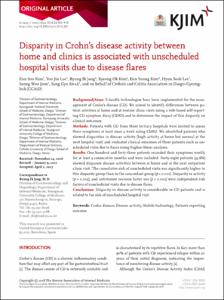KUMEL Repository
1. Journal Papers (연구논문)
1. School of Medicine (의과대학)
Dept. of Internal Medicine (내과학)
Disparity in Crohn’s disease activity between home and clinics is associated with unscheduled hospital visits due to disease flares
- Keimyung Author(s)
- Lee, Yoo Jin
- Department
- Dept. of Internal Medicine (내과학)
- Journal Title
- Korean J Intern Med.
- Issued Date
- 2018
- Volume
- 33
- Issue
- 5
- Abstract
- Background/Aims: E-health technologies have been implemented for the management of Crohn’s disease (CD). We aimed to identify differences between patient activities at home and at routine clinic visits using a web-based self-reporting CD symptom diary (CDSD) and to determine the impact of this disparity on clinical outcomes.
Methods: Patients with CD from three tertiary hospitals were invited to assess their symptoms at least once a week using CDSD. We identified patients who showed disparities in disease activity (high activity at home but normal at the next hospital visit) and evaluated clinical outcomes of these patients such as unscheduled visits due to flares using Kaplan-Meier analyses.
Results: One hundred and forty-three patients recorded their symptoms weekly for at least 3 consecutive months and were included. Forty-eight patients (33.6%) showed disparate disease activities between at home and at the next outpatient clinic visit. The cumulative risk of unscheduled visits was significantly higher in this disparity group than in the concordant group (p = 0.001). Disparity in activity (p = 0.003), and anti-tumor necrosis factor use (p = 0.002) were independent risk factors of unscheduled visits due to disease flares.
Conclusions: Disparity in disease activity is considerable in CD patients and is related to the risk of unscheduled hospital visit.
- Keimyung Author(s)(Kor)
- 이유진
- Publisher
- School of Medicine (의과대학)
- Citation
- Eun Soo Kim et al. (2018). Disparity in Crohn’s disease activity between home and clinics is associated with unscheduled hospital visits due to disease flares. Korean J Intern Med., 33(5), 902–910. doi: 10.3904/kjim.2016.387
- Type
- Article
- ISSN
- 2005-6648
- Source
- http://kjim.org/journal/view.php?doi=10.3904/kjim.2016.387
- Appears in Collections:
- 1. School of Medicine (의과대학) > Dept. of Internal Medicine (내과학)
- 파일 목록
-
-
Download
 oak-2018-1550.pdf
기타 데이터 / 807.83 kB / Adobe PDF
oak-2018-1550.pdf
기타 데이터 / 807.83 kB / Adobe PDF
-
Items in Repository are protected by copyright, with all rights reserved, unless otherwise indicated.